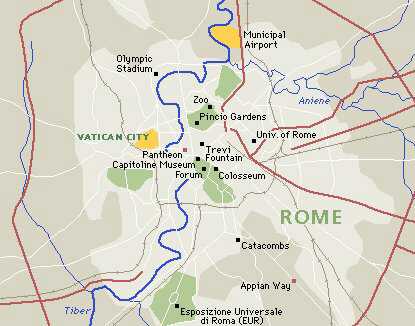

![]()

Rome (in Italian Roma), is the capital city of Italy, of Rome Province and Latium Region. It is the seat of the Italian government and of the supreme court. It is also the seat of the Roman Catholic Church, the Vatican which is in the Vatican City. The city has a population of 2,687,881 (1993 est.); 3,175,000 persons (1991), 2,791,354 (1990 est.); 887,000 (1930 est.) and 226,000 (1870 est.).
Position
It is located on the bank of the Tiber River between the Apennine Mountains and the Tyrrhenian Sea (24-17km / 15-17miles to the west). The city was originally situated there because it is the first easy crossing of the Tiber upstream from the sea.
Economy and Transportation
The economy is based on government operations, tourism and industry. Infact, the majority of its workers are employed in any one of these fields. Rome has been selected to hold the headquarters of many multinational corporations and agencies, some of which are the United Nations Food and Agriculture Organization (FAO), International Fund for Agriculture Development (IFAD), World Food Council and World Food Program.
Rome throughout its history was mainly an Administative centre rather than an Idustrial centre. Altogh it is the largest city in Italy its industry activity is less than those in the cities of the north of Italy. The industries in Rome includes metallurgy, electronics, glass, cement and textile manufactures. However, the banking; insurance; printing; publishing and fasion industries are quite important. Another important industry is stationed at the Cinecittą (cinema city), which is the Italian Movie industry.
On the other hand, Rome is also the centre of the transport companies. It is the central point in Italy's railroad system (including the main Termini station). It have two main international airports the Ciampino (an older airport, southeast of the city) and Leonardo Da Vinci International Airport (the newer facility and the main airport, to the southwest, at Fiumicino) and is one of the busiest in Europe. Subway systems serve the city.
Educational and Cultural
Rome is the site of Italy's largest institution of higher education, the state-run University of Rome (Founded in 1303) enrolls about 180,000 students. It also have several church-run colleges; academies of fine art and the oldest music academy in the world, Conservatorio di Musica Santa Cecilia (1570).
In Italy's cultural life the city plays a leading role in the creative and performing arts and in most other aspects. Opera is performed in one of country's best building, the Opera House and at the Baths of Caracalla in the summer. Varied reperatory during the fall, winter and spring is offered by the 20 theaters and 6 major concert halls.
Among the world's greatest museum one can find many of them located at Rome. Great classic collections can be found in Rome. The richest collections can be found in the Vatican museums and gallaries while many other great classic collections can be found in the National and Capitoline museums. The Borghese, Corsini, Doria and Colonna collections contain magnificent paintings. The Opera House is one of the Europe's finest cultural buildings. Parks and gardens make more cultural.Landmarks
Ancient ruins
I. Colosseum - built 72-81ADby Emperor Vespasian and his sons Titus and Domitian. It was used for gladiatoral contest.
II. Catacombs - they were the early Christian and some Jewish subterranean cemetries. Sometime were used as a place of refuge. III. Forum - The political and commercial site.. IV. Arch of Constantine V. Baths of Caracalla - every bath was 24,281.16m2 and with the walls enclosed an area of 109,265.22m2. VI. Circus Maximums - founded in the 6th century. It was used for horse and chariot races, now no longer standing. VII. Pantheon - founded 27 BC and rebuilt 118-128 AD, considered one of the finest surviving temples of antiquity. Palaces
Note : The Italian word "Palazzo" in English means "Palace"
I. Castel Sant'Angelo - built by Hadrian in 135-139 AD. II. Vatican Place - contains the Sistine Chapel.
III. Villa Farnesina IV. Villa Borghese V. Palazzo Doria VI. Palazzo Barberini VII. Palazzo Corsini
Squares
Note : The Italian word "Piazza" in English means "Square"
I. Piazza del Popolo II. Piazza di Spagna III. Piazza Colonna IV. Piazza Quirinale V. Piazza Campidoglio
Churches
I. Basilica di San Paolo (Saint Peter's Basilica) - build on the tomb of the apostle by Costantine, and was rebuilt in the 16th and 17th centuries. II. San Giovanni in Laterno (Basilica of Saint John Lateran) - the Cathedral of Rome (founded in the 4th century) III. San Paolo Fuori le Mura (Saint Peter outside the walls) - founded by Costantine, and before the fire of 1823 was a most interesting church. IV. Santa Maria Maggiore - founded in the 4th century and was named Basilica Liberiana.
Monuments
I. Victor Emmanuel II (the second) - to commemorates the unification of Italy